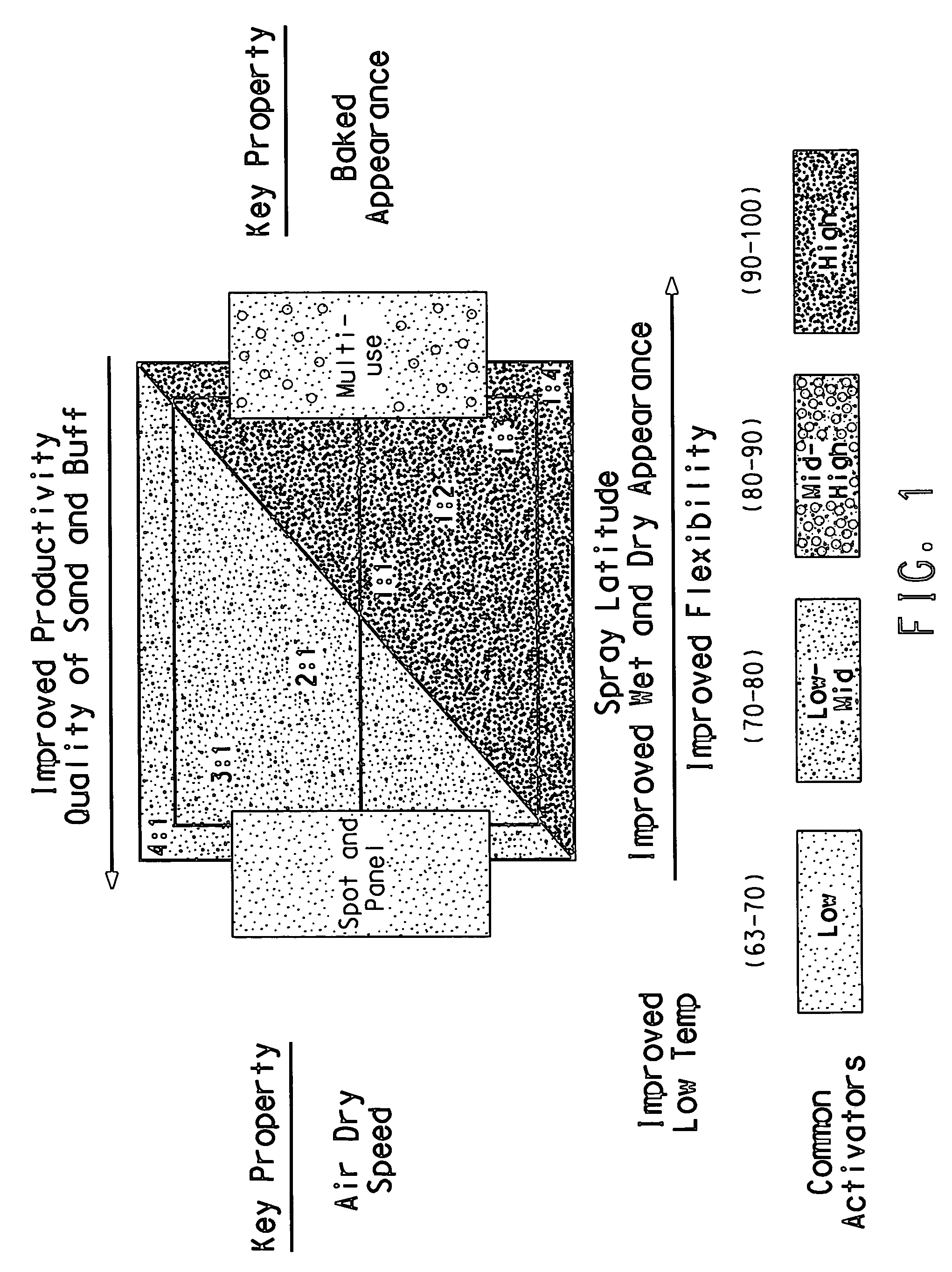Process for producing coating compositions with customizable properties
a technology of coating composition and customizable properties, applied in the field of coating compositions, can solve the problems of exacerbated high inventory problem, high equipment requirements, and varying the needs of each application
- Summary
- Abstract
- Description
- Claims
- Application Information
AI Technical Summary
Benefits of technology
Problems solved by technology
Method used
Image
Examples
example 1
Blending of an Overall Clearcoat with a Spot and Panel Clearcoat
[0072]The following two different binder and one activator components were provided and used to formulate various coating compositions as shown below:
Preparation of an Overall Clearcoat Binder Portion (Part 1)
[0073]
IngredientsParts by WeightAcrylic polymer #36611.47Polyester oligomer #2271.06Acrylic Copolymer #41841Tinuvin 384169.1Tinuvin 292165.78Methyl amyl ketone2412.41Acetone16.22Dibutyl Tin dilaurate46.8Ethyl-3-ethoxypropionate579.15BYK 306241.46BYK 358249.01Xylene222.231Available from Ciba Specialty Chemicals, Tarrytown, NY2Available from BYK Chemie, Wallingford, CT.
[0074]To a can, all of the components in Part 1 are added in the order given with mixing. After the last addition, mixing was continued for 30 minutes. Components in Part 2 were then accurately weighed and added in the order give with mixing. The blend continued to mix for one hour before filling out into individual gallon cans. The following propertie...
example 2
Room Temperature Blending of a Spot and Panel Clearcoat with an Overall Clearcoat to Produce a Clearcoat for a Low Bake System with varying Dry Time and Appearance
[0094]The following clearcoats were prepared:
[0095]Clearcoat 1-500 mL of the binder portion of an overall clear formulation (Part 1 of overall clear above) was combined with 125 mL of common activator (prepared above) (Part 2). The solution had an initial Zahn 2 viscosity of 14:96 seconds (4:1). The composition was sprayed by an application expert in two coats (at 75° F.) over DuPont Chromabase® basecoat (light blue metallic) and were baked for 30 minutes at 140° F. in an Accudraft (downdraft) booth. The dry time after one coat was 8 minutes. The coating sprayed well and had good appearance. The thickness of the coating was 2.7 mils and the wavescan measurement was LI 1.8 and S 13.1 after 2 hours. Thirty minutes after bake, the print value was 4. This clearcoat served as the “control” since it contained 100% overall clearc...
example 3
Moderate Temperature Blending of a Spot and Panel Clearcoat with an Overall Clearcoat to Produce an Air-Dry Clearcoat with varying Appearance and Handling
[0109]The same components as above were used.
[0110]The following clearcoats were prepared:
[0111]Clear 1-300 mL of spot and panel clear binder (Part 1) as above and 300 mL of overall clear binder formulation (Part 1) as above were combined with stirring and then 150 mL of common activator (Part 2) as above was added to activate the blend. The solution had an initial Zahn 2 viscosity of 13.8 seconds. Within fifteen minutes, the composition was sprayed in a downdraft spray booth by an application expert in two coats (at 74° F.) over Chromabase basecoat. The dry time after one coat was 7 minutes. After the second coat, the system was air dried at 74° F. The coating sprayed well (good atomization and roll out). Overspray drift was measured to be over 40 inches. Print hardness increased from 2 at 90 minutes to 5 at 4 hours, and the coati...
PUM
| Property | Measurement | Unit |
|---|---|---|
| temperatures | aaaaa | aaaaa |
| temperature | aaaaa | aaaaa |
| temperature | aaaaa | aaaaa |
Abstract
Description
Claims
Application Information
 Login to View More
Login to View More - R&D
- Intellectual Property
- Life Sciences
- Materials
- Tech Scout
- Unparalleled Data Quality
- Higher Quality Content
- 60% Fewer Hallucinations
Browse by: Latest US Patents, China's latest patents, Technical Efficacy Thesaurus, Application Domain, Technology Topic, Popular Technical Reports.
© 2025 PatSnap. All rights reserved.Legal|Privacy policy|Modern Slavery Act Transparency Statement|Sitemap|About US| Contact US: help@patsnap.com


